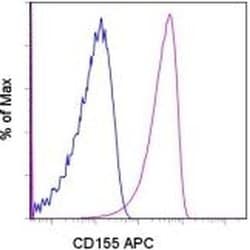Learn More
Invitrogen™ CD155 Monoclonal Antibody (TX56), APC, eBioscience™
Rat Monoclonal Antibody
Supplier: Invitrogen™ 17155182

Description
Description: This TX56 monoclonal antibody reacts with mouse CD155 (also known as poliovirus receptor or PVR), a member of the Ig superfamily of nectins and nectin-like proteins. CD155 is expressed on thymocytes (e.g. CD4+CD8+ and CD4+ cells), peripheral T and B lymphocytes (e.g. regulatory T cells, activated T cells, marginal zone B cells, and plasma cells), natural killer (NK) cells, dendritic cells (e.g. mature and activated), and monocytes. CD155 interacts with other nectins, including Nectin-3 and the extraceullar matrix protein vitronectin, the adhesion molecule CD226/DNAM-1, and the NK cell receptor CD96. CD155 plays a role in cell-cell adhesion, including formation of adherens junctions, cell migration, polarization, and NK-mediated cytotoxicity. In humans, but not in mice, CD155 is the receptor for poliovirus. Applications Reported: This TX56 antibody has been reported for use in flow cytometric analysis. Applications Tested: This TX56 antibody has been tested by flow cytometric analysis on mouse thymocytes. This can be used at less than or equal to 1 μg per test. A test is defined as the amount (μg) of antibody that will stain a cell sample in a final volume of 100 μL. Cell number should be determined empirically but can range from 10^5 to 10^8 cells/test. It is recommended that the antibody be carefully titrated for optimal performance in the assay of interest. Excitation: 633-647 nm; Emission: 660 nm; Laser: Red Laser. Filtration: 0.2 μm post-man...
The protein encoded by this gene is a transmembrane glycoprotein belonging to the immunoglobulin superfamily. The external domain mediates cell attachment to the extracellular matrix molecule vitronectin, while its intracellular domain interacts with the dynein light chain Tctex-1/DYNLT1. The gene is specific to the primate lineage, and serves as a cellular receptor for poliovirus in the first step of poliovirus replication. Multiple transcript variants encoding different isoforms have been found for this gene.
Specifications
| CD155 | |
| Monoclonal | |
| 0.2 mg/mL | |
| PBS with 0.09% sodium azide; pH 7.2 | |
| 0 | |
| PVR | |
| Affinity chromatography | |
| RUO | |
| 52118 | |
| 4°C, store in dark, DO NOT FREEZE! | |
| Liquid |
| Flow Cytometry | |
| TX56 | |
| APC | |
| PVR | |
| 3830421F03Rik; AI325026; AI987993; CD112; CD155; D7Ertd458e; FLJ25946; herpes virus entry mediator B; Herpesvirus entry mediator B; hveB; HVED; mE4; mHveB; Mph; murine herpes virus entry protein B; murine herpesvirus entry protein B; NECL5; necl-5; Nectin cell adhesion molecule 2; Nectin2; Nectin-2; nectin-like 5; nectin-like protein 5; Poliovirus receptor; poliovirus receptor homolog; poliovirus receptor-related 2; poliovirus receptor-related protein 2; poliovirus sensitivity; PVR; Pvrl2; PVS; sCD112; soluble CD112; Taa1; TAGE4; tumor-associated antigen 1; tumor-associated glycoprotein pE4 | |
| Rat | |
| 100 μg | |
| Primary | |
| Mouse | |
| Antibody | |
| IgG2a |
Safety and Handling
The Fisher Scientific Encompass Program offers items which are not part of our distribution portfolio. These products typically do not have pictures or detailed descriptions. However, we are committed to improving your shopping experience. Please use the form below to provide feedback related to the content on this product.
